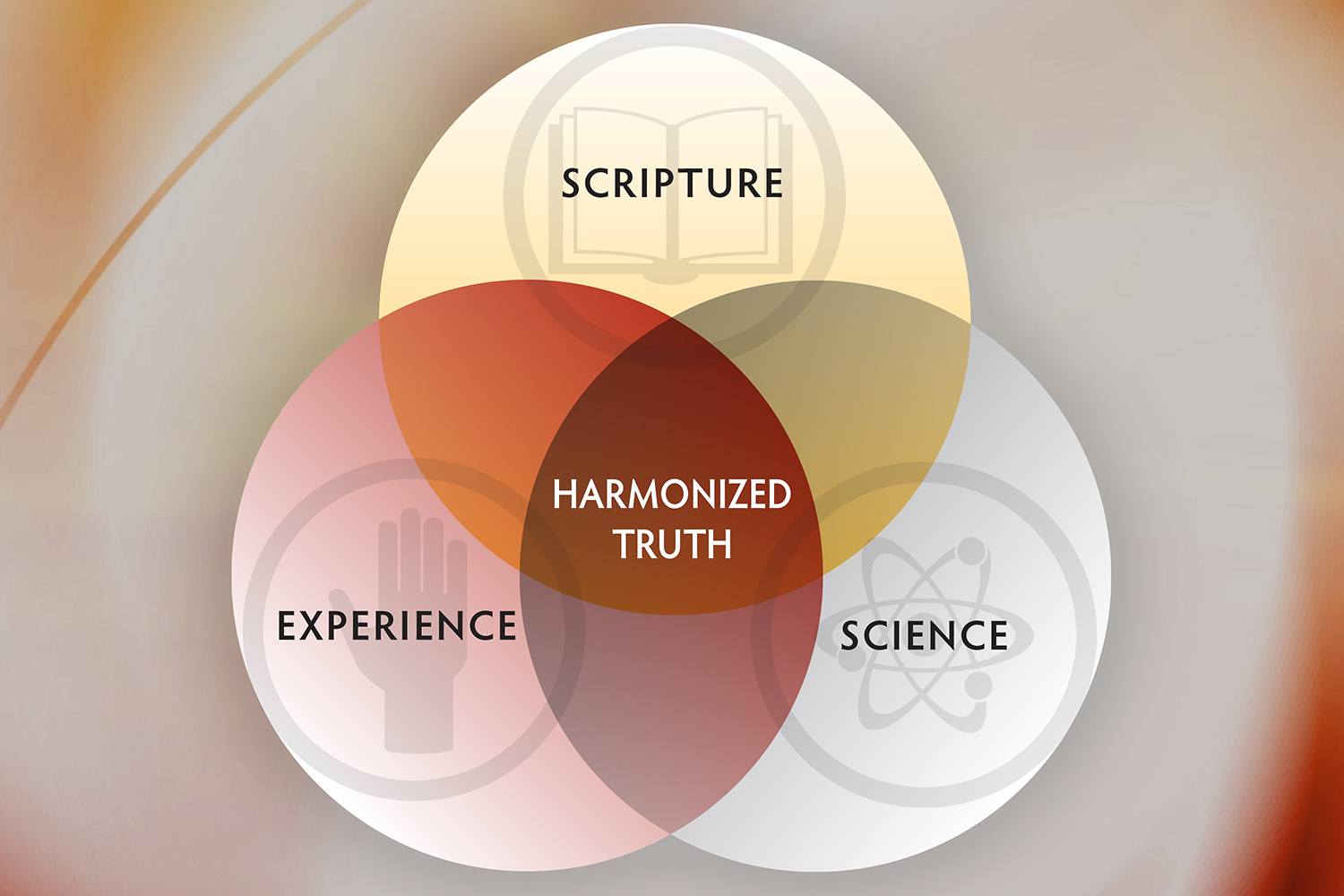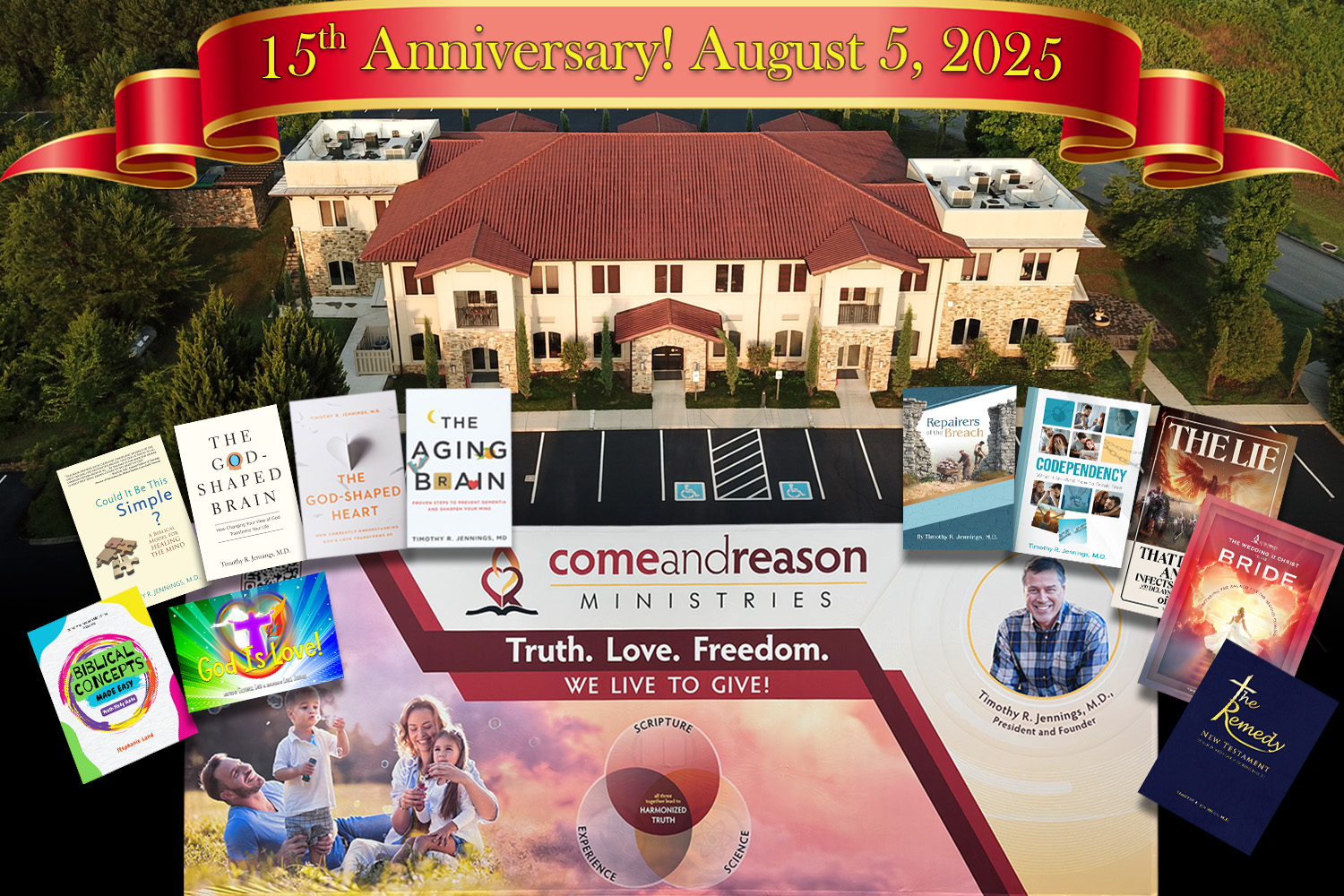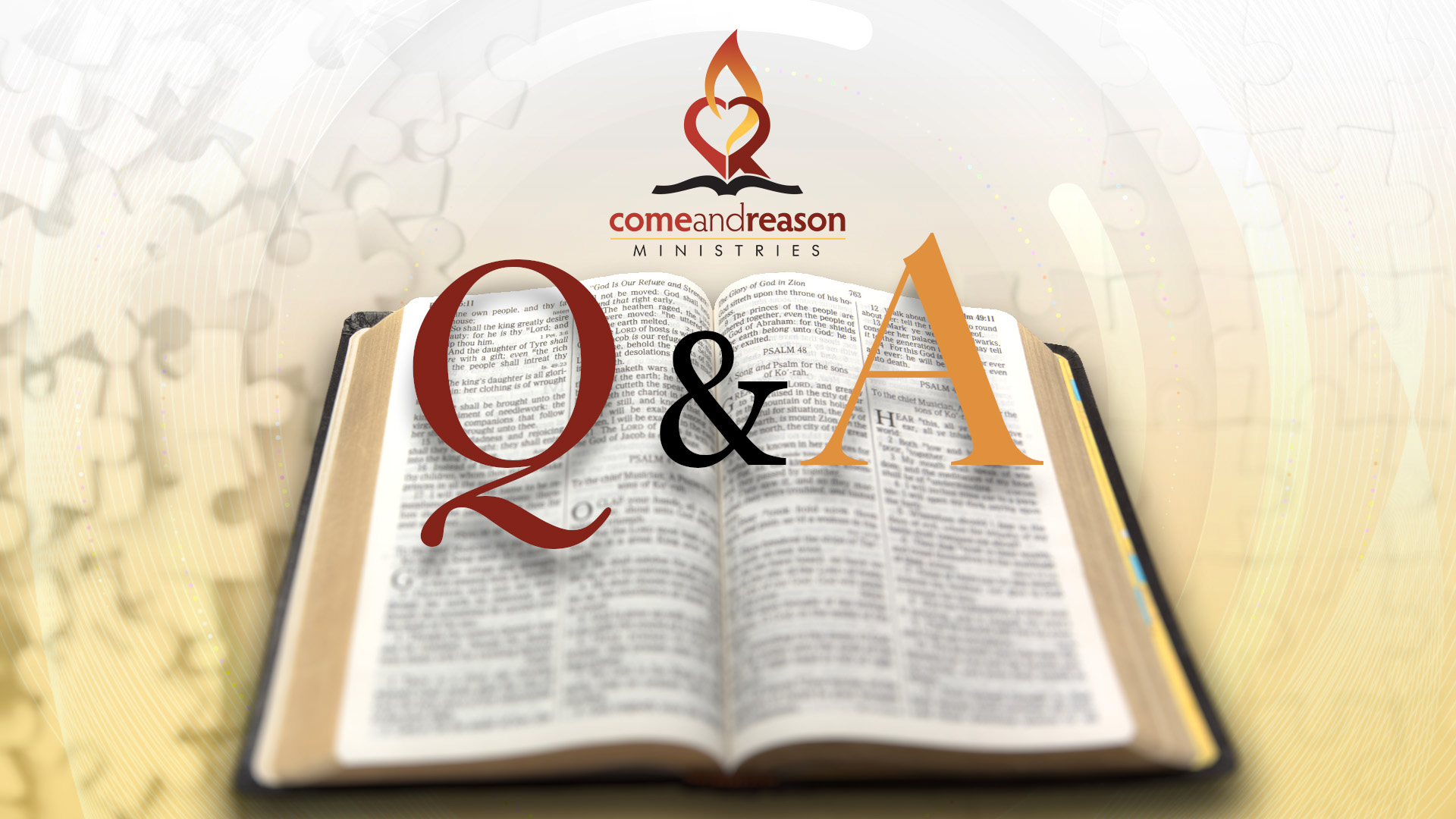Come and Reason Ministries has utilized and extensively taught the ‘Integrative Evidence-Based Approach’ to finding truth for many years, but I recently discovered that we did not have a place on our website with a description of it, nor references documenting its godly origin. Therefore, here is a brief description and example, followed by many references.
Harmonizing Scripture, Science/Nature, and Experience
‘The Integrative Evidence-Based Approach’ to finding truth requires that we harmonize three threads of evidence: Scripture, Science/Nature, and Experience.
Each of these threads are provided by God and each is vital to our understanding of Him, His creation, and His law of love. Our risk of getting confused and drawing erroneous conclusions about the world increase when we separate these three threads and fail to integrate them.
- Science all by itself leads to godlessness.
- Experience all by itself leads to mysticism.
- Scripture all by itself leads to confusion. (For instance, according to the Christian encyclopedia, more than 30,000 Christian groups are arguing about what various Bible passages mean.)
Examples of Problems that Arise When Failing to Integrate the Three Threads
- In the sixteenth century, Galileo discovered that the earth revolves around the sun. The leaders of the predominant Christian church taught, however, that the sun revolves around the earth and that the earth was the center of the universe. Refusing to integrate observable science and Scripture, they placed Galileo under house arrest and contributed to a rift between religion and science that continues to this day.
- Evolutionary theories of the origins of life utilize evidences from nature and science but fail to harmonize those with Scripture and draw false conclusions about the origins of life.
- Eastern-style meditation practices (and other “prayer” styles) reject both science and Scripture and make internal experience the measure of enlightenment and truth, leading to mystical experiences and false conclusions of reality.
Applying the Integrative Evidence-Based Approach
- God’s law in Scripture:
- “The entire law is summed up in a single command: ‘Love your neighbor as yourself’” (Galatians 5:14).
- “If you really keep the royal law found in Scripture, ‘Love your neighbor as yourself,’ you are doing right” (James 2:8).
- “Jesus replied: ‘Love the Lord your God with all your heart and with all your soul and with all your mind.’ This is the first and greatest commandment. And the second is like it: ‘Love your neighbor as yourself.’ All the Law and the Prophets hang on these two commandments” (Matthew 22:37–40).
- Love is not self-seeking (1 Corinthians 13:5); this means love gives.
- God’s law in nature:
- Every time you exhale, you give away CO2; in turn, the plants give oxygen back to you. This is just one example of many in nature that point to the never-ending circle of love upon which life is built to operate.
- God’s law in experience:
- Epidemiologic studies document that people who volunteer (give of themselves) live longer, have less disability, less dementia, and stay out of nursing homes longer than those who don’t volunteer.
References Documenting that God’s Method for Revealing Truth Is the Integrative Evidenced-Based Approach
God speaks to us through science/nature (His first book):
- “Ask the animals, and they will teach you, or the birds of the air, and they will tell you; or speak to the earth, and it will teach you, or let the fish of the sea inform you. Which of all these does not know that the hand of the Lord has done this?” (Job 12:7–9 NIV84).
- “The heavens declare the glory of God; the skies proclaim the work of his hands” (Psalm 19:1 NIV84).
- “For since the creation of the world God’s invisible qualities — his eternal power and divine nature — have been clearly seen, being understood from what has been made, so that men are without excuse” (Romans 1:20 NIV84).
- “Since complete happiness is knowing God, in order that no one should be prevented from finding that happiness, he has kindly put in our minds the seed of true religion we have already spoken of and has also displayed his perfection in the whole structure of the universe. So he is constantly in our view and we cannot open our eyes without being made to see him. His nature is incomprehensible, far beyond all human thought, but his glory is etched on his creation so brightly, clearly, and gloriously that no one however obtuse and illiterate can plead ignorance as an excuse. So with absolute truth the Psalmist exclaims, ‘He wraps himself in light as with a garment’ (Psalm 104:2). It is as though he was saying that when God created the world for the first time, he put on outer clothes. He hung up gorgeous banners on which we see his perfection clearly portrayed. In the same place the Psalmist aptly compares the spread of the heavens with God’s royal tent and says he, ‘lays the beams of his upper chambers on their waters. He makes the clouds his chariot and rides on the wings of the wind’ (Psalm 104:3): sending out he wind and lightning as his swift messengers. Because the glory of his power and wisdom is more ablaze in the heavens, it is frequently called his palace. Wherever you look, there is no part of the world however small that does not show at least some glimmer of beauty; it is impossible to gaze at the vast expanse of the universe without being overwhelmed by such tremendous beauty. So the author of the epistle to the Hebrews sensitively describes the visible world as an image of the invisible (Hebrews 11:3). The superb structure of the world acts as a sort of mirror in which we may see God, who would otherwise be invisible. For the same reason the Psalmist attributes language to heavenly bodies, a language which all nations can understand (Psalm 19:1). … However, although the display which God gives of himself and his eternal kingdom is brightly reflected in the mirror of creation, we are so stupid and dim that we deserve no benefit from them. How few of us, as we look up to the skies or around at the earth, ever think of the Creator! We tend to overlook him and content ourselves with simply looking at the creation. … Creation lights up all these bright lamps to demonstrate the glory of the Creator to us, all in vain. Although they shine on us from every direction, they are quite insufficient in themselves to lead us into the right way. They do, undoubtedly, throw out some sparks, but these are put out before they can give a brighter glow” (John Calvin, The Institutes of the Christian Religion ed. Tony Lane and Hilary Osborne, p. 32, 33, my emphasis).
- “The pure of heart see all things full of God. They see him in the firmament of heaven, in the moon walking in brightness, in the sun when he rejoiceth as a giant to run his course. They see him ‘making the clouds his chariots, and walking upon the wings of the wind.’ They see him ‘preparing rain for the earth,’ ‘and blessing the increase of it.’” (John Wesley, Sermon 23, “Sermon on the Mount, III,” §I.1, Works 1:513, my emphasis).
- “Some people, in order to discover God, read books. But there is a great book: the very appearance of created things. Look above you! Look below you! Note it. Read it. God, whom you want to discover, never wrote that book with ink. Instead He set before your eyes the things that He had made. Can you ask for a louder voice than that? Why, heaven and earth shout to you: ‘God made me!’ (St. Augustine [354-430] ~ Sermon 126.6 in the Angelo Mai collection, Miscellanea Agustiniana 1:355–68, ed. G. Moran [Rome, 1930], in Vernon Bourke, trans. The Essential Augustine, Hackett, Indianapolis, 1974, p.123).
- “For it follows, ‘All the beasts of the wood shall drink’ (Ps. 104:11). We indeed see this in the visible creation, that the beasts of the wood drink of springs, and of streams that run between the mountains. But since it has pleased God to hide his wisdom in the figures of such things (as animals and parts of creation), not to take it away from earnest seekers, but to close it to them who care not, and open it to them that knock. It has also pleased our Lord God Himself to exhort you by us to this, that in all these things which are said as if of the bodily and visible creation, we may seek something spiritually hidden, in which when found we may rejoice. … Holy Scripture witnesses this in many places” (St Augistine ~ Expositions on the Book of Psalms. Commentary on Psalm 104, v.10, 11. Nicene and Post-Nicene Fathers of the Christian Church, Vol. XII, pg. 511, 512 Ed. Philip Schaff. Erdmans, 1989, my emphasis).
- “Many are the ways in which God is seeking to make Himself known to us and bring us into communion with Him. Nature speaks to our senses without ceasing. The open heart will be impressed with the love and glory of God as revealed through the works of His hands. The listening ear can hear and understand the communications of God through the things of nature” (E.G. White, Steps to Christ, p. 85).
God speaks to us through life experiences (His second book):
- “Taste and see that the Lord is good” (Psalm 34:8 NIV84).
- “Then he said to Thomas, ‘Put your finger here; see my hands. Reach out your hand and put it into my side. Stop doubting and believe’” (John 20:27 NIV84).
- “God speaks to us through His providential workings and through the influence of His Spirit upon the heart. In our circumstances and surroundings, in the changes daily taking place around us, we may find precious lessons if our hearts are but open to discern them” (E.G. White, Steps to Christ, p. 87).
God speaks to us through Scripture (His third book):
- “Beginning with Moses and all the Prophets, [Jesus] explained to them what was said in all the Scriptures concerning himself. … They asked each other, ‘Were not our hearts burning within us while he talked with us on the road and opened the Scriptures to us?’” (Luke 24:27, 32 NIV84).
- “All Scripture is inspired by God and is useful for teaching the truth, rebuking error, correcting faults, and giving instruction for right living” (2 Timothy 3:16 GNB).
- “God speaks to us in His word. Here we have in clearer lines the revelation of His character, of His dealings with men, and the great work of redemption” (E.G. White, Steps to Christ, p. 87).
God’s Method for Establishing Truth Harmonizes Scripture, Science/Nature, and Experience
- Jesus taught that God provided these three threads to be harmonized:
- He quoted Scripture (in synagogue, to disciples, and on the road to Emmaus).
- He taught God’s truths with examples in nature: wheat falls to ground, dies, yet brings life; parable of sower; provisions for sparrows and the lilies of the fields; healing ministry acting out plan of salvation.
- He used personal experience as a teaching method: “Then he said to Thomas, ‘Put your finger here; see my hands. Reach out your hand and put it into my side. Stop doubting and believe’” (John 20:27).
John Wesley (Methodists) taught Scripture must be harmonized with experience and reason:
- Scripture is to be understood in harmony with tradition (the evidence of God’s principles working through history), experience (personal life experience with God), and reason (rational evidence-based thinking). This came to be known as the Wesleyan Quadrilateral.
Ellen G. White (Seventh-day Adventists) taught Scripture must be harmonized with science and experience:
- “The great storehouse of truth is the word of God — the written word, the book of nature, and the book of experience in God’s dealing with human life. Here are the treasures from which Christ’s workers are to draw. In the search after truth they are to depend upon God, not upon human intelligences, the great men whose wisdom is foolishness with God. Through His own appointed channels, the Lord will impart a knowledge of Himself to every seeker” (E.G. White, Christ’s Object Lessons, p. 125, my emphasis).
- “Rightly understood, both the revelations of science and the experiences of life are in harmony with the testimony of Scripture to the constant working of God in nature (E.G. White, Education, p. 130, my emphasis).
- “Jesus followed the divine plan of education. The schools of His time, with their magnifying of things small and their belittling of things great, He did not seek. His education was gained directly from the Heaven-appointed sources; from useful work, from the study of the Scriptures and of nature, and from the experiences of life — God’s lesson books, full of instruction to all who bring to them the willing hand, the seeing eye, and the understanding heart” (Ibid, p. 77, my emphasis).
- “The Scripture says, ‘All these things spake Jesus unto the multitude in parables; … that it might be fulfilled which was spoken by the prophet, saying, I will open My mouth in parables; I will utter things which have been kept secret from the foundation of the world’ (Matthew 13:34, 35). Natural things were the medium for the spiritual; the things of nature and the life — experience of His hearers were connected with the truths of the written word. Leading thus from the natural to the spiritual kingdom, Christ’s parables are links in the chain of truth that unites man with God, and earth with heaven.” (E.G. White, Christ’s Object Lessons, p. 17, my emphasis).









 using your credit or debit card (no PayPal account needed, unless you want to set up a monthly, recurring payment).
using your credit or debit card (no PayPal account needed, unless you want to set up a monthly, recurring payment). instead?
instead?